Sort by:


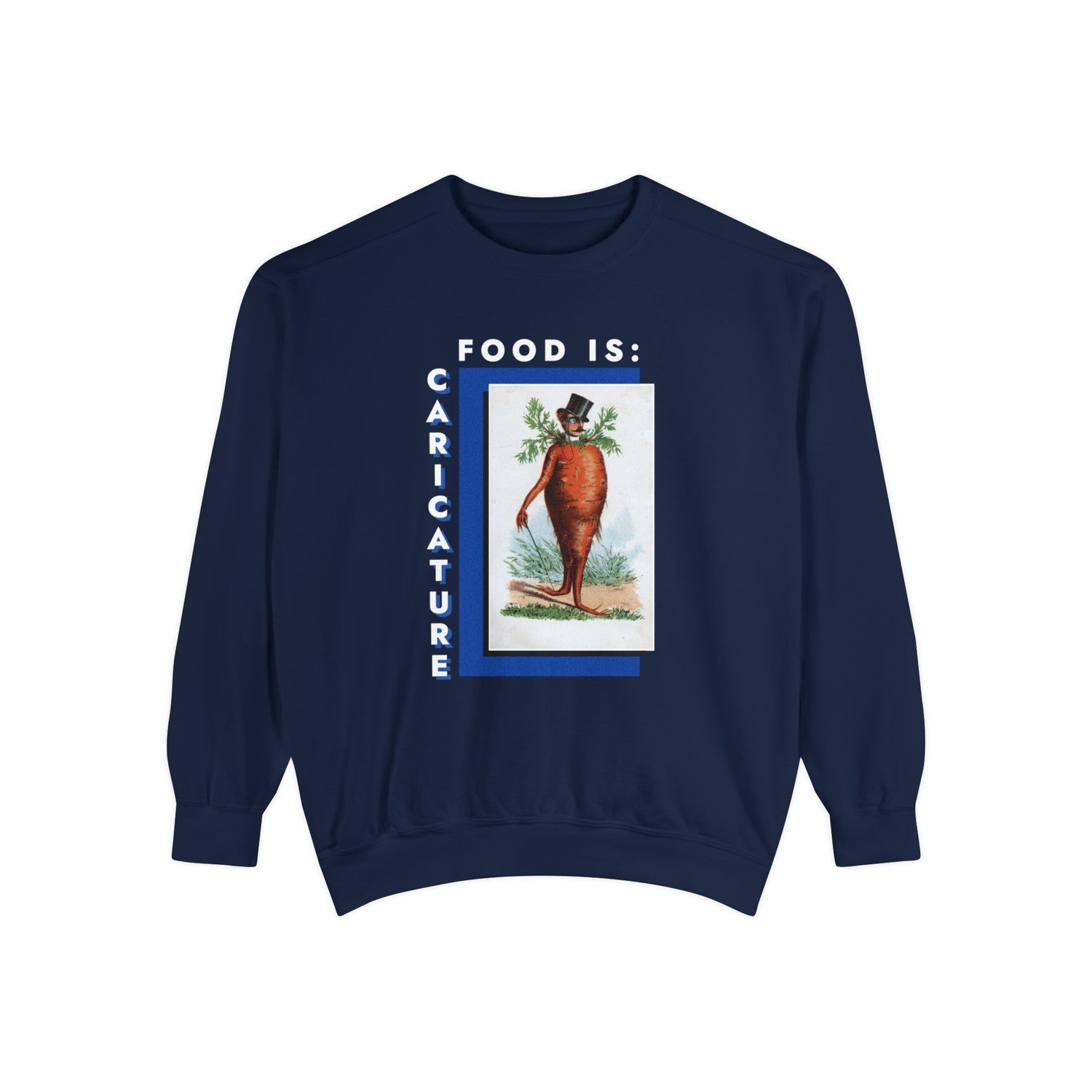
Food is: Caricature | Unisex Sweatshirt - Dapper Gentleman Carrot
$57.00
Unit price perFood is: Caricature | Unisex Sweatshirt - Dapper Gentleman Carrot
$57.00
Unit price perAbout the Artwork:
While the specific artist behind the artwork on this advertisement card remains unknown, the print was produced by Clay & Richmond, a Buffalo, New York-based printing and publishing company that flourished in the mid-19th century. They were known for their quirky and often humorous chromolithographs, a type of colored print popular during that era.
This particular chromolithograph features a man's head, sporting a neatly trimmed beard and a serious expression, attached to the body of a plump carrot. The carrot figure is further adorned with a top hat and a monocle, the accessories of a sophisticated gentleman. The overall effect is comical while succeeding in capturing an air of elegance to the carrot gentleman.
Image courtesy of Boston Public Library via the Digital Commonwealth Collection.


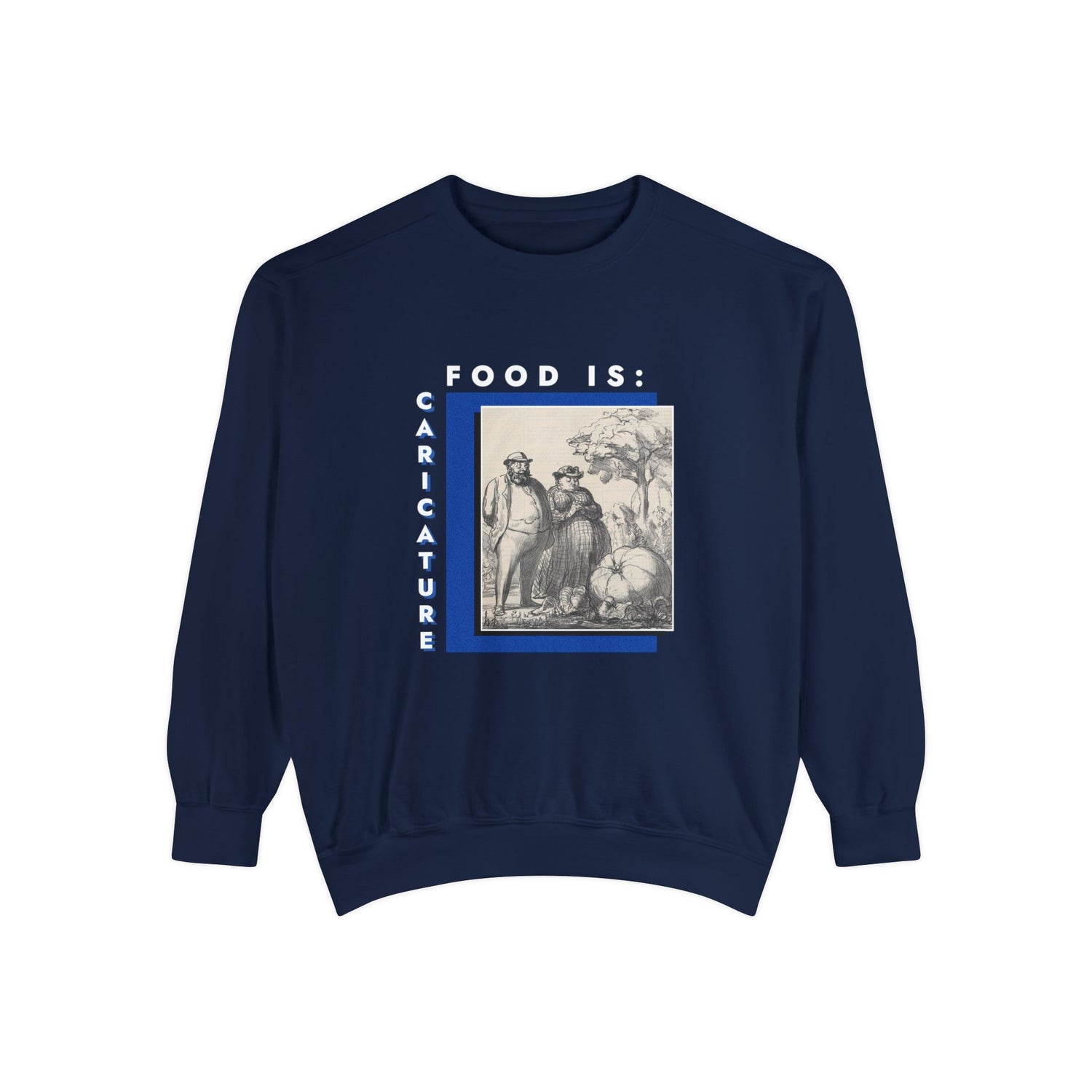
Food is: Caricature | Unisex Sweatshirt - The King of Pumpkins
$57.00
Unit price perFood is: Caricature | Unisex Sweatshirt - The King of Pumpkins
$57.00
Unit price perAbout the Artwork:
Honoré Daumier, born in 1808 in Marseille, France, was a prolific and influential French artist known for his caricatures, paintings, and sculptures that keenly critiqued the social and political atmosphere of 19th-century France. Daumier's work, often published in periodicals such as La Caricature and Le Charivari, employed humor and satire to expose the follies and injustices of his time. His sharp wit and insightful portrayals have made him one of the most respected figures in the realm of political and social commentary through art.
This artwork is a lithograph that showcases Daumier’s unique blend of satire and visual narrative. "The king of pumpkins receiving the homage of his subjects" presents a scene where a large, round man and his partner survey various autumnal produce, including pumpkins. Daumier references pumpkins and the depiction of the large bodied people to create a scenario of a regal couple presiding over their subjects.
Image courtesy of the Met's Open Access Initiative.
About the Artwork:
Amédéé Varin (active mid-19th century) was a French caricaturist known for his witty and often bizarre illustrations. While details about his life remain scarce, his surviving works offer a glimpse into the playful and satirical artistic circles of 19th-century France. Varin's "Carotte conjugale" ("Married Carrot") is a prime example, using a common vegetable to deliver a humorous and thought-provoking commentary on marital relations.
The artwork features a woman's face and torso forming into a carrot. She is garbed in the greens of the vegetable and embraces, presumably, her husband who is also depicted in vegetable form. The couple appears to be situated in a shared home on a sofa, with artwork of another vegetable persona hung on the wall behind them.
Image courtesy of the Minneapolis Institute of Art (Mia) under a CC-PDM license.
About the Artwork:
Honoré Daumier, born in 1808 in Marseille, France, was a prolific painter, sculptor, and caricaturist renowned for his sharp critique of French society and politics during the 19th century. Daumier’s work is celebrated for its satire, often focusing on the lives of the Parisian working class, the foibles of the bourgeoisie, and the corruption within the judicial system. His approach made use of lithography to reach a broad audience.
"Le bon morceau" is a striking example of Honoré Daumier's keen eye for social commentary and human behavior. The artwork depicts a diner at a table greedily eyeing a cut of meat. This figure's exaggerated features and the intense focus on the piece of meat serve to emphasize the themes of gluttony and selfishness.
Image courtesy of the National Gallery of Art, Washington via its Open Access Initiative.

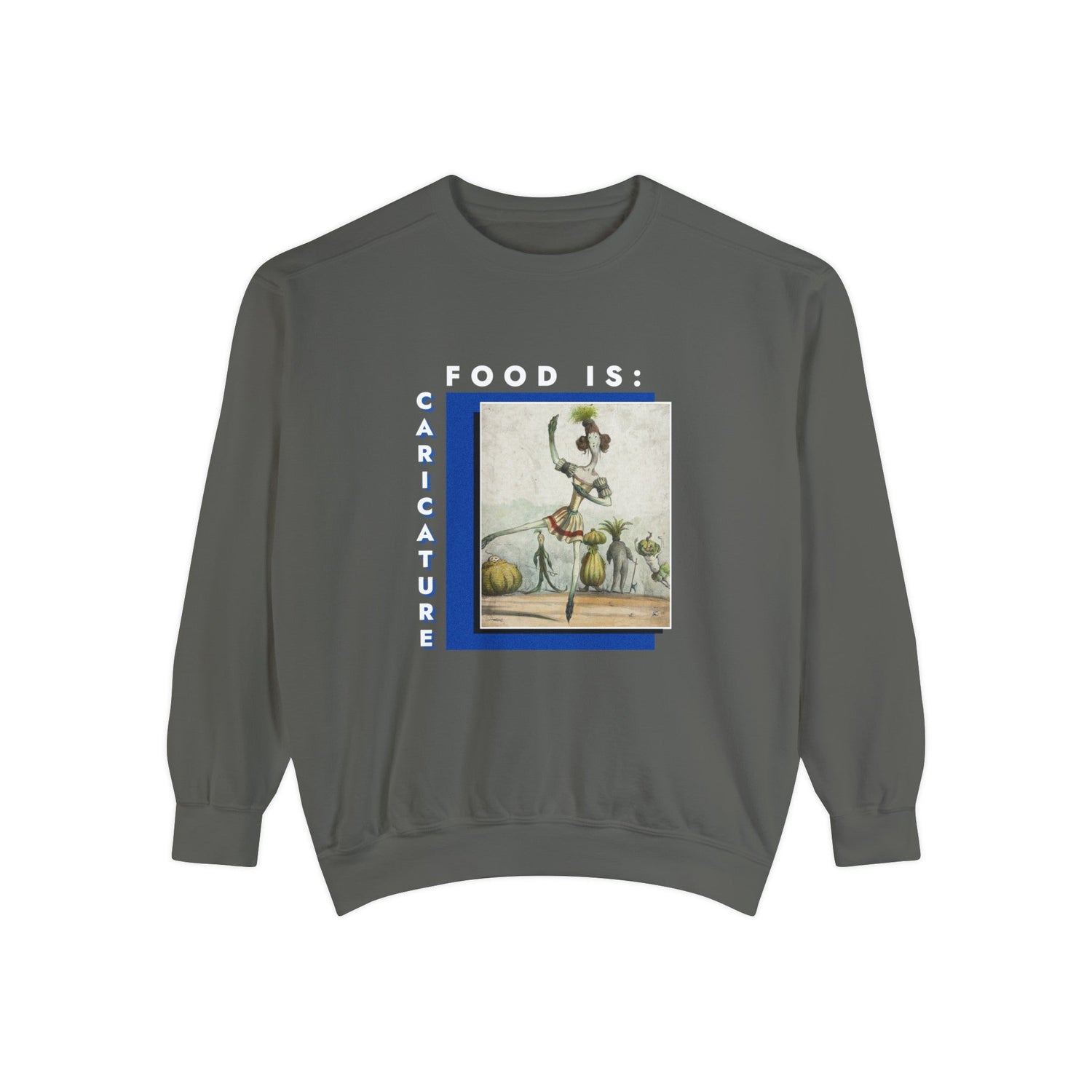
Food is: Caricature | Unisex Sweatshirt - Asparagus Ballet Dancer
$57.00
Unit price perFood is: Caricature | Unisex Sweatshirt - Asparagus Ballet Dancer
$57.00
Unit price perAbout the Artwork:
Grégoire Caboche, an intriguing French artist of the 19th century, produced this artwork that illustrates a caricature of a performer from the Académie Royale de Musique, portrayed humorously as an asparagus in a vegetable-themed ballet. The painting captures her on stage, elegantly costumed in the likeness of the vegetable, complete with a slender, elongated bodice and a flared green skirt mimicking asparagus tips. The background suggests a theatrical setting with exaggerated and colorful props representing other vegetables, creating a lively and enchanting atmosphere.
Image courtesy of the New York Public Library's Digital Collections.
About the Artwork:
John Leech was an English caricaturist and illustrator, born in 1817 in London, known for his sharp wit and role in shaping British satirical art. Leech worked extensively for the magazine Punch, where he contributed drawings that highlighted the absurdities and contradictions within Victorian society. His work is celebrated for its humor, expressive characters, and ability to critique social norms while still engaging a broad audience. Leech’s illustrations not only entertained but also provided commentary on politics, culture, and everyday life, making him a key figure in the development of British cartoon and comic art.
"Vegetarian Odd Fellows" is an example of John Leech's humorous and satirical style, depicting two men as a carrot and parsnip. The man depicted as a parsnip appears to be elderly and is referred to by Leech as "Pa-Snip," potentially indicating a familial connection between the two figures or simply intending to highlight an age disparity. The other figure "Carrott" is aiding Pa-snip as the two engage in yard or farm labor.
Image courtesy of the Met's Open Access Initiative.

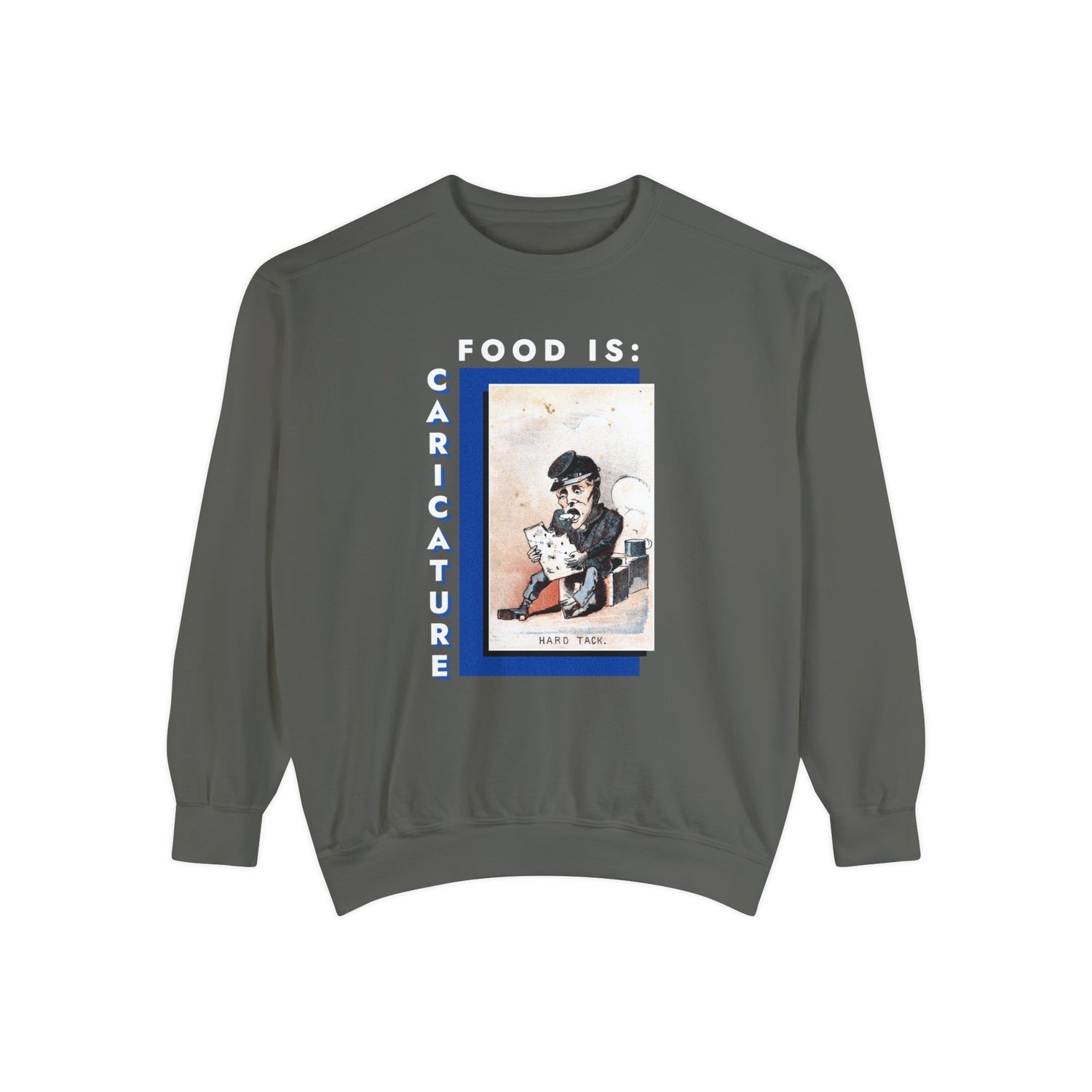
Food is: Caricature | Unisex Sweatshirt - Solider with Hard Tack
$57.00
Unit price perFood is: Caricature | Unisex Sweatshirt - Solider with Hard Tack
$57.00
Unit price perAbout the Artwork:
Winslow Homer, born in 1836 in Boston, Massachusetts, stands as one of the titans of 19th-century American art, known for his vivid and detailed portrayals of American life and landscapes. He began his artistic career as a commercial illustrator, and his experience as a wartime correspondent during the Civil War profoundly influenced his later works. Homer is celebrated for his powerful depictions of nature and human endurance, often highlighting the interplay of human figures within expansive landscapes, using both oil and watercolor to stunning effect.
In 1864, Winslow Homer created lithographed collector's cards called "Life in Camp." In these works, Homer employed a humorous tone to engage in small reflections on military life. This image captures a Union soldier's grimace in reaction to hard tack, a widely disliked basic ration that was a necessary source of nutrition during the war.
Image courtesy of the Met's Open Access Initiative.
About the Artwork:
Amédée Varin, an artist active in the 19th century, was known for his imaginative and often whimsical illustrations that blended botanical elements with human characteristics. Varin's work typically involved elaborate depictions of plants and flowers anthropomorphized in a variety of scenes that both amused and fascinated viewers. His unique style captures an intersection of nature and human culture.
"Cucurbitus 1er/ Costume d'apparat" demonstrates Amédée Varin’s distinctive approach to botanical illustration. This artwork portrays a majestic figure, adorned in attire that mimics the form and texture of gourd vegetables. Varin’s meticulous attention to detail highlights the characteristics of the gourd, transforming them into a dignified presence that commands respect and curiosity.
Image courtesy of the Minneapolis Insitute of Art (Mia).

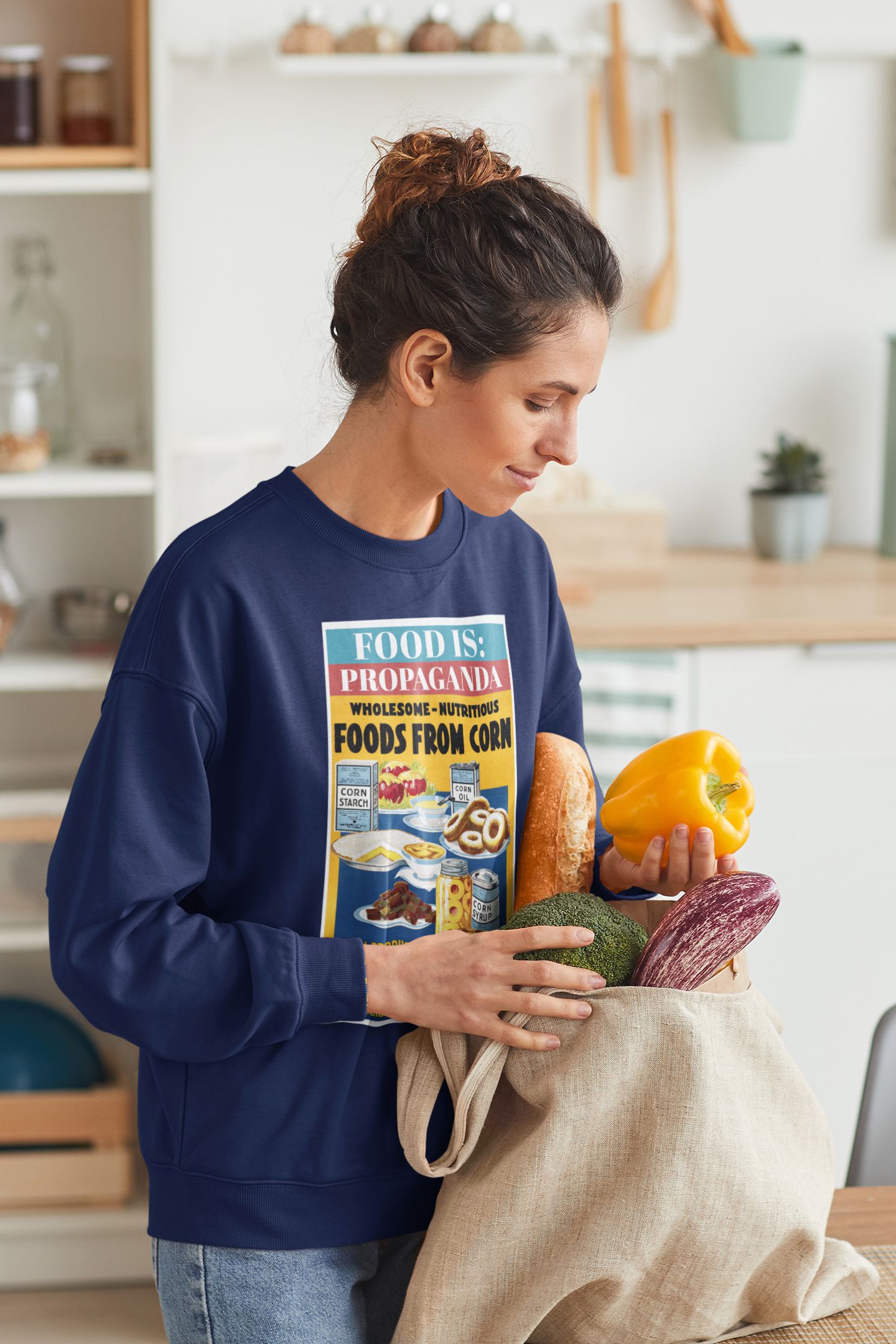
Food is: Propaganda | Unisex Sweatshirt - Promoting Use of Corn
$57.00
Unit price perFood is: Propaganda | Unisex Sweatshirt - Promoting Use of Corn
$57.00
Unit price perAbout the Artwork:
Lloyd Harrison (1864-1931) was an American commercial artist known for his vibrant and detailed illustrations. Active during the early 20th century, Harrison primarily created advertisements for various companies. However, his work for the U.S. Food Administration during World War I holds historical significance. Posters like "Wholesome – Nutritious: Foods from Corn" aimed to educate the public about alternative food sources during wartime shortages.
This colorful poster features a festive display of corn-based products. The composition is an array of tempting dishes made with corn. Baked goods like bread and cake sit alongside cans of corn starch and corn oil. The text "Wholesome – Nutritious. Foods from Corn" arches boldly across the top, emphasizing the health benefits of corn.
"Wholesome – Nutritious: Foods from Corn" served a dual purpose during World War I. As wheat supplies dwindled, the U.S. Food Administration encouraged citizens to incorporate more corn into their diets. The abundance of corn-based dishes showcased in the poster demonstrates the versatility of this grain. From breakfast staples like pancakes to savory grits, the artwork highlights corn's potential to satisfy a variety of culinary needs.
Image courtesy of Boston Public Library Digital Commonwealth Collections.

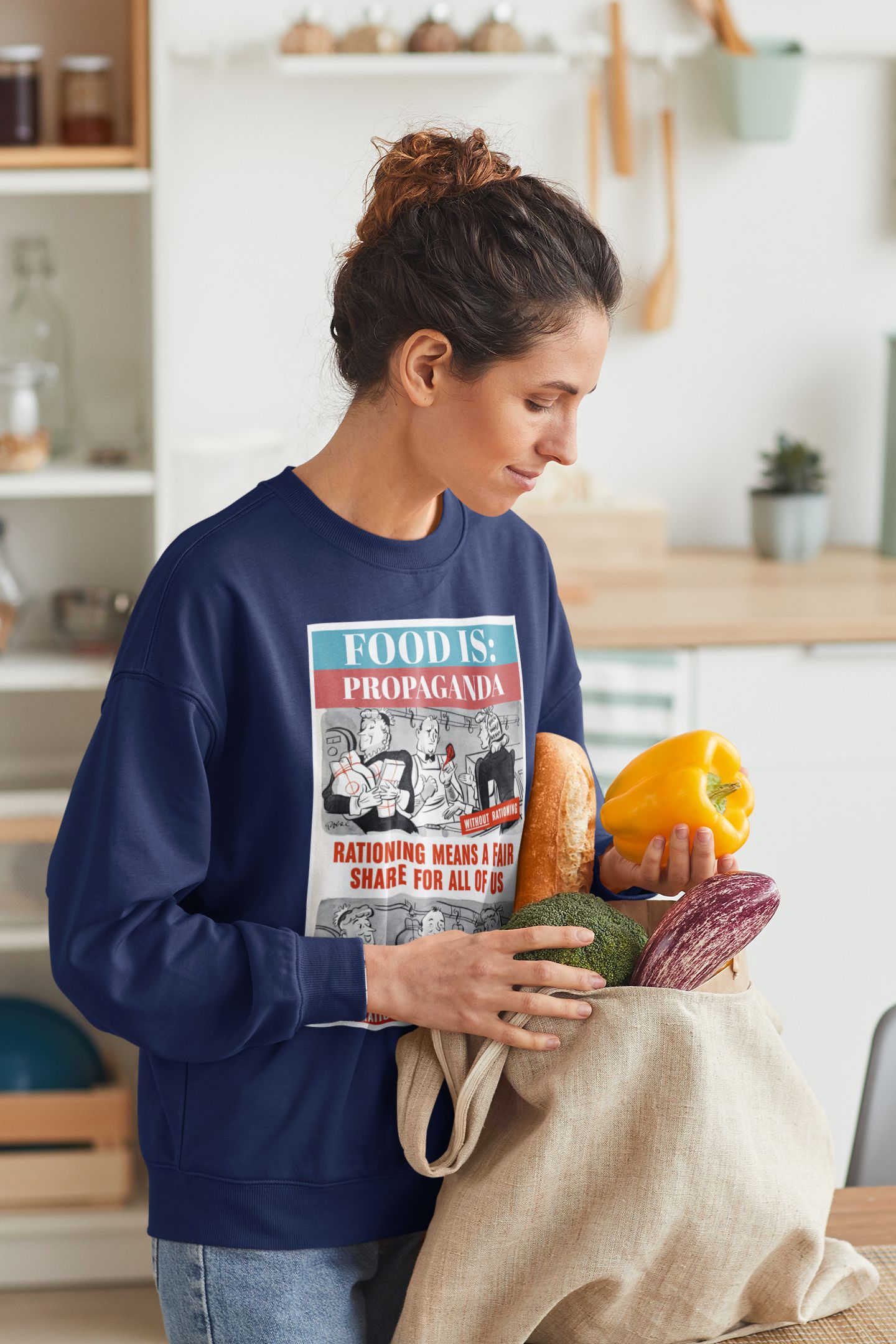
Food is: Propaganda | Unisex Sweatshirt - Fair Share Rationing
$57.00
Unit price perFood is: Propaganda | Unisex Sweatshirt - Fair Share Rationing
$57.00
Unit price perAbout the Artwork:
Herbert Roese (1905-1986) was a prolific American commercial artist and illustrator active during the mid-20th century. While Roese created illustrations for various purposes, his work for the U.S. Office of Price Administration (OPA) during World War II holds particular significance. The OPA played a crucial role in managing wartime shortages through rationing. Posters like "Rationing Means a Fair Share for Us All" aimed to explain and garner public support for this essential wartime measure.
This seemingly straightforward poster utilizes a clever visual approach to convey its message. Divided into two distinct sections, the artwork tells a story. The top half depicts a scene of frustration. A woman appears to be trying to make a purchase without success at a local butcher, with a meager offering behind the counter. While another customer leaves with her purchases, the latter figure has no options to buy from. The bottom half presents a stark contrast. Two women, each holding a ration book and a small package, smile as they leave a well-stocked butcher shop. The text "Rationing Means a Fair Share for Us All" stretches across the top, emphasizing the poster's central message.
Image courtesy of Boston Public Library Digital Commonwealth Collections.

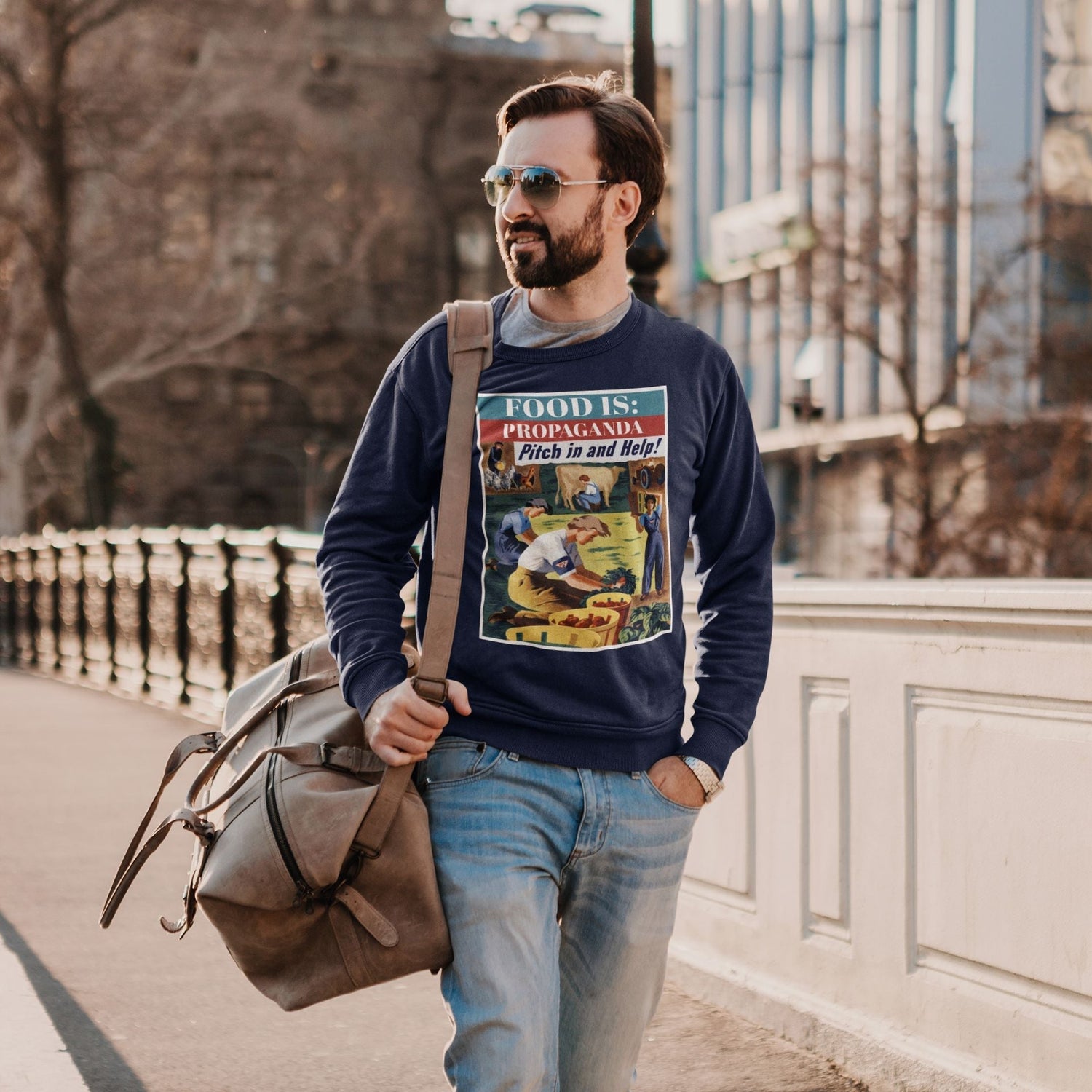
Food is: Propaganda | Unisex Sweatshirt - Join the Women's Land Army
$57.00
Unit price perFood is: Propaganda | Unisex Sweatshirt - Join the Women's Land Army
$57.00
Unit price perAbout the Artwork:
Hubert Morley (1888-1951) was an American painter, etcher, and commercial artist. While Morley's career spanned various artistic mediums, he's particularly recognized for his contributions to the war effort during World War II. Morley created numerous posters for the U.S. government, motivating the public to support the war cause through rationing, production increases, and civilian participation.
"Pitch in and Help! Join the Women's Land Army of the U.S. Crop Corps" features four American women working on a farm. One drives a tractor, another milks a cow, and two others harvest vegetables and tend to chickens. Their expressions are determined and focused. The title urges viewers to "Pitch in and Help!" by joining the Women's Land Army.
Image courtesy of Boston Public Library Digital Commonwealth Collections.

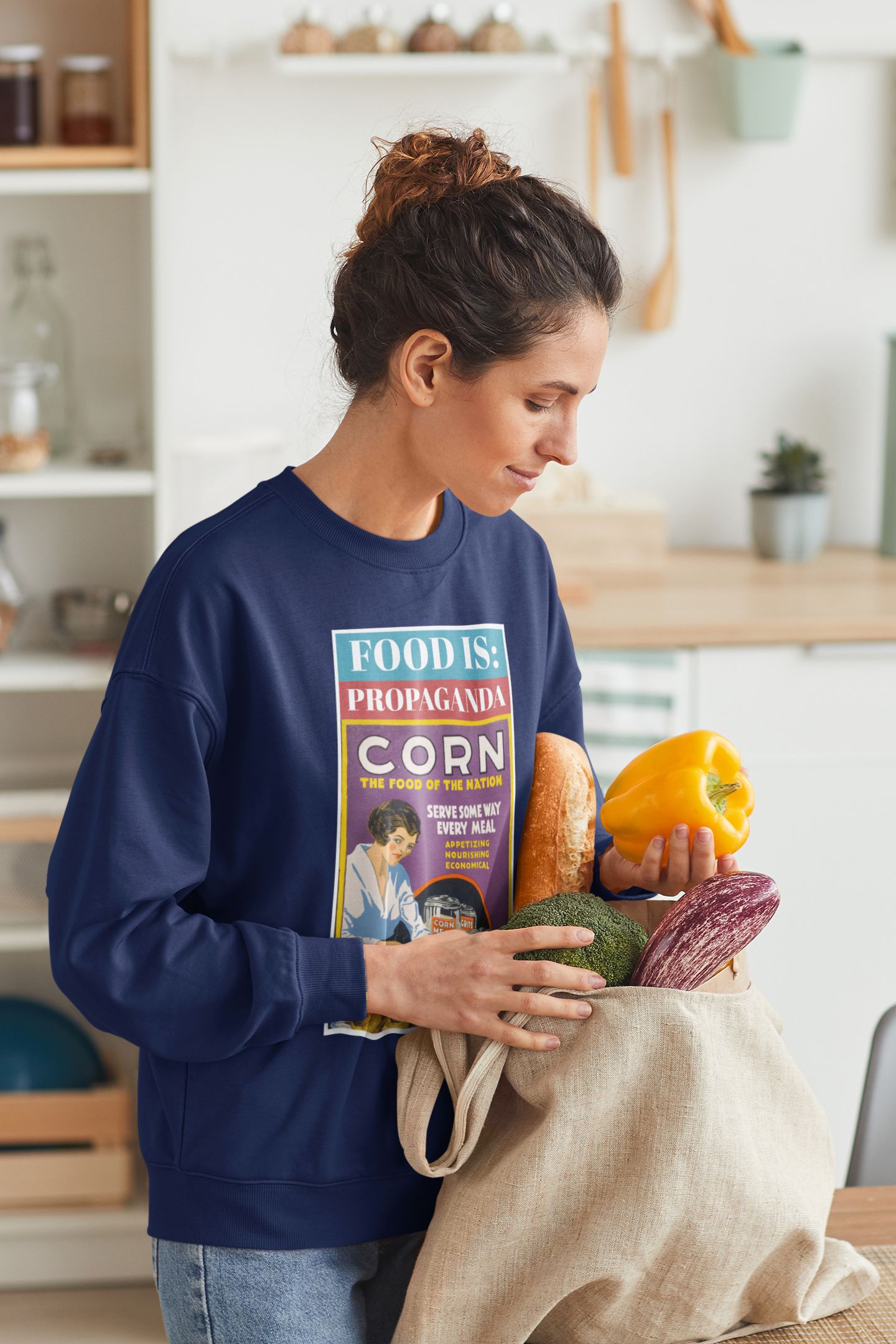
Food is: Propaganda | Unisex Sweatshirt - Corn the Food of the Nation
$57.00
Unit price perFood is: Propaganda | Unisex Sweatshirt - Corn the Food of the Nation
$57.00
Unit price perAbout the Artwork:
Lloyd Harrison was an accomplished graphic artist known for his impactful and compelling propaganda posters, particularly those produced during World War I. Harrison's work often combined bold imagery with persuasive slogans to influence public opinion and motivate specific behaviors during a time of national need. His style is characterized by vibrant colors and dynamic compositions, which were effective in capturing the attention of a broad audience. His posters not only served practical purposes during wartime but also stand as significant historical documents that provide insight into the socio-political climate of the early 20th century.
"Corn - the Food of the Nation" by Lloyd Harrison is a striking propaganda poster that was part of a larger effort to encourage American consumers to adjust their food consumption habits during World War I. The artwork features a woman preparing baked goods like muffins and pancakes, which sit alongside canisters labeled "corn meal," "grits," and "hominy."
Image courtesy of Boston Public Library Digital Commonwealth Collections.








